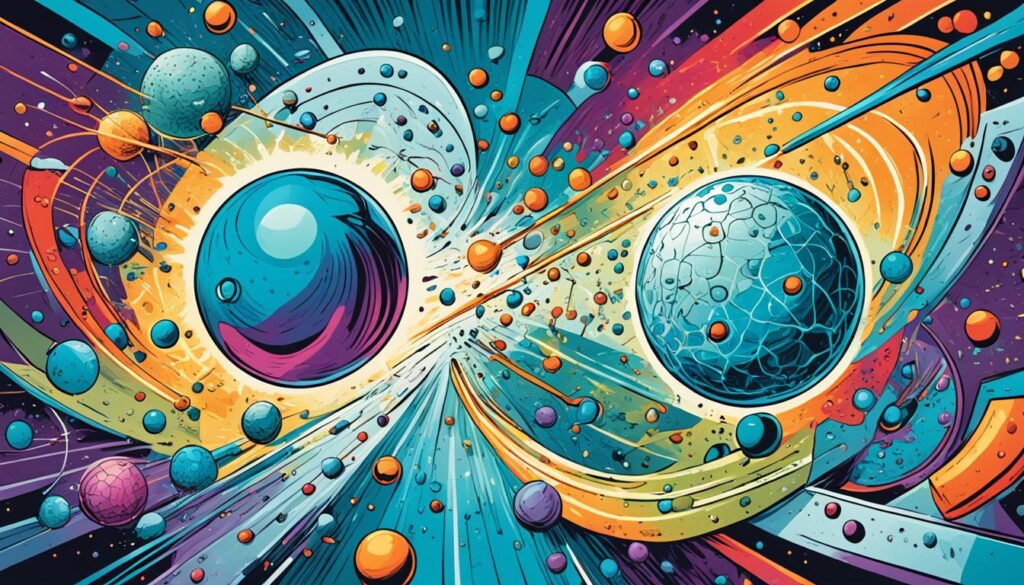Comic books have long been a source of entertainment and leisure for people worldwide. They are known for their captivating stories, vivid characters, and stunning visuals. However, they can also be a powerful teaching tool that delivers complex scientific concepts in an engaging and accessible way. In this article, we will explore the exciting world of scientific concepts in comic books, also known as science comics or science in graphic novels. We will analyze the accuracy, educational value, and role of science education in comics, using examples from popular culture. Are you ready to dive into the enthralling world of comics and science? Let’s begin!
The Role of Science Education in Comics
Comic books have long been recognized for their entertainment value, but did you know they also have a significant role in science education? Using captivating storytelling and visual representations, comics can effectively teach STEM concepts and engage readers in scientific principles.
By incorporating science learning through comics, readers are exposed to a range of STEM concepts in an accessible and enjoyable way. This approach combines the benefits of traditional learning, such as textbooks and classroom instruction, with the appeal of comics to spark curiosity and engage readers of all ages.


For example, comics can be used to explain complex scientific concepts like relativity, quantum mechanics, and astrophysics. Through visually stunning illustrations and creative storytelling, abstract scientific principles become more tangible and comprehensible. Readers of all ages can relate to superheroes fighting against villains and can also learn about physics, biology, and even chemistry without feeling overwhelmed or intimidated.
The Benefit of STEM Concepts in Comic Books
By introducing STEM concepts in comic books, these educational materials can also broaden the scope of traditional science education. While textbooks and classroom lectures typically present a sanitized, oversimplified version of science, comics can convey knowledge while entertaining. They can help build a foundation of curiosity, which can drive students to learn more about science and pursue careers in STEM fields.
The comic book culture is a natural fit for teaching science. It’s long been an art form that simplifies complex concepts into digestible packages. With science, you are always trying to boil it down to its simplest components. It’s a simple language that’s spoken in visual terms.
Comics also serve as valuable resources for educators to teach the next generation of scientists and innovators. The visual and narrative aspects can bring a new dimension to classroom instruction, making the learning process more dynamic and engaging.
Scientific Principles in Comic Books
Comic books have become more than just a form of entertainment. They have also become a medium for educating readers on scientific principles. Many comic writers and artists have been incorporating scientific concepts into their narratives to create stories that are both entertaining and educational.
The incorporation of scientific principles in comic books is not limited to just physics and chemistry. It extends to a variety of scientific fields such as biology, genetics, and psychology. Superheroes like Spider-Man, for instance, have utilized concepts such as genetics and neurology in their storylines. These instances showcase the versatility of comic books in exploring different scientific avenues.
One notable example of incorporating scientific concepts into comic books is Neil deGrasse Tyson’s “The Physics of Superheroes,” a series that explores the physics behind superheroes’ abilities. Tyson offers insights into the science of comic book characters and their abilities, stunning visuals, and intriguing explanations that will impress even the most knowledgeable comic book reader.


“Comic books offer a unique opportunity for readers to engage with science in a fun and accessible way. The incorporation of scientific principles into comic book narratives offers a compelling way for people to learn about science outside of the classroom,” stated Dr. Jane Foster, a science communication expert.
The depiction of scientific principles in comic books provides readers with a better understanding of science and its applications. It also sparks readers’ curiosity, which may lead them to further explore science-related topics. In conclusion, the fusion of entertainment and education through the incorporation of scientific principles in comic books provides a unique opportunity for readers to engage with science on a different level and inspires a lifelong love for science learning.
Comics as Science-Based Graphic Storytelling
Comics are a unique form of storytelling that combine visuals and narrative to create engaging and accessible experiences. Science-based graphic storytelling is a type of comic that focuses specifically on scientific concepts and ideas, using the medium to communicate complex topics in a way that is both compelling and educational.
One of the advantages of science-themed comics is the ability to use visuals to convey scientific ideas. Research has shown that people are more likely to remember information when it is presented in a visual format. For example, a comic about the structure of an atom can use illustrations to show the various components and their relationships in a way that is both accurate and easy to understand.


In addition to visual aids, comics also have the advantage of storytelling. By incorporating narrative with scientific concepts, writers and artists can draw readers into the subject matter and make it more engaging and relatable. For example, a comic about climate change can use characters and plot to address the causes and effects of the issue in a way that is informative, but also emotionally resonant.
Furthermore, science-based graphic storytelling can also serve as a gateway for readers to explore scientific concepts further. By using comics to introduce concepts in an accessible format, readers can gain an understanding and appreciation for scientific ideas that might otherwise seem intimidating or unapproachable.
The Intersection of Science and Art
Science and art might seem like opposite ends of the spectrum, but science-based graphic storytelling has shown that there is significant overlap between the two. Scientific concepts can inspire creative storytelling, while visual representations can help make complex scientific topics digestible and appealing.
“By marrying scientific concepts with engaging storytelling, science-themed comics can inspire readers of all ages to explore the wonders of science further.”
| Benefits of Science-Based Graphic Storytelling | Examples |
|---|---|
| Visual representation makes complex scientific topics accessible | The Sandwalk Adventures: An Evolutionary Naturalist Tale by Jay Hosler |
| Narrative hooks draw readers into scientific concepts | XKCD: A webcomic of romance, sarcasm, math and language by Randall Munroe |
| Promotes scientific literacy and curiosity | PhD Comics by Jorge Cham |
The intersection of science and art in comics is constantly growing, as more writers and artists experiment with science-themed storytelling. By marrying scientific concepts with engaging storytelling, science-themed comics can inspire readers of all ages to explore the wonders of science further.
The Accuracy of Scientific Concepts in Comics
While comics can be an amazing source for science-themed storytelling, there have been instances where scientific accuracy has been compromised for the sake of plot development and reader engagement. However, many comics have been praised for their scientific precision, bringing attention to specific concepts and theories.
One example is Marvel’s Iron Man. The comic accurately depicts Tony Stark’s creation of his high-tech suit, highlighting the importance of technological advancements as well as the scientific principles empowering them. Another example is physicist Jim Kakalios’s graphic novel The Physics of Superheroes which explores the limits of superheroes’ abilities and how they illustrate scientific concepts.
That said, comics are not immune to inaccuracy. In some cases, scientific facts can be twisted to fit a creative narrative. While comics can be a great source of entertainment and education, we must remain vigilant about the accuracy of scientific concepts portrayed in comics.


“Comics are a great source of education and entertainment, but we should always strive for accuracy in our depictions of scientific concepts.”
The Educational Value of Science Comics
Science education in comics is a fascinating and effective way to introduce science to young audiences. Through science-themed comics, readers immerse themselves in a world of discovery and adventure, where scientific concepts come to life in vivid detail. Not only can science comics enhance science learning, but they can also foster curiosity and inspire readers to explore scientific concepts further.
Science learning through comics provides an interactive and exciting learning experience that engages readers on both a visual and emotional level. By using captivating storytelling and strong visuals, science comics can make complex scientific ideas more accessible and easier to understand, regardless of the reader’s age or prior knowledge on the subject.
Moreover, science comics can inspire readers to pursue careers in science, technology, engineering, and math (STEM) fields. By creating relatable characters and storylines, readers can see themselves represented in the characters and become inspired to pursue similar paths.
“Science comics can be a hugely effective tool to inspire young learners and make learning about science fun and engaging. It’s amazing how much information can be conveyed through a well-told story with strong visuals.”
The Benefits of Science Comics in Education
Science comics have many benefits in education, including:
| Benefits of Science Comics in Education | Description |
|---|---|
| Easy to Understand | Science-themed comics can make complex concepts more accessible to readers. |
| Foster Interest and Curiosity | Science comics can capture readers’ attention, making them eager to learn more about science. |
| Inspiration | Science comics can inspire readers to pursue careers in science and technology fields. |
| Alternative to Traditional Textbooks | Science comics offer an alternative to traditional textbooks, making learning more fun and engaging. |
Overall, science comics offer a unique and valuable way to learn about science. They inspire and educate readers of all ages, making science education accessible, fun, and engaging.
Conclusion
In conclusion, exploring the scientific concepts in comic books has revealed their tremendous educational value. Science-themed comics not only entertain readers but can also effectively teach STEM concepts. The fusion of science and storytelling in comics sparks curiosity and inspires readers of all ages to further explore scientific principles.
The accuracy of scientific concepts portrayed in comic books may vary, but the overall educational value of science comics remains undeniable. By using captivating visual representations, science-based graphic storytelling has the power to engage readers in the wonders of science and enhance science learning.
Thus, from the physics-defying abilities of superheroes to science-based storylines, comic books offer a unique and engaging medium for conveying complex scientific concepts. So, let’s dive into the fascinating world of science in comics and discover the educational value of scientific concepts in comic books.
Scientific Concepts in Comic Books are not only exciting but also educative. Read more to discover the sheer brilliance of science-based graphic storytelling!
